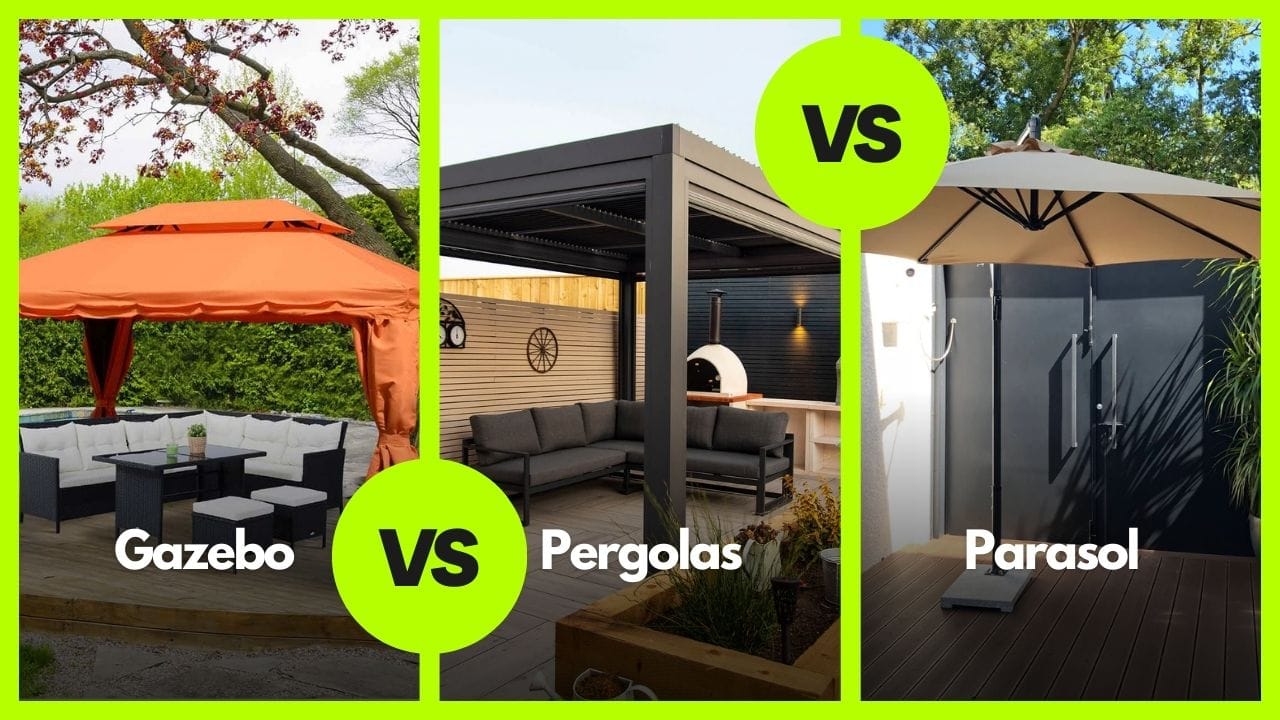Are you considering a pergola, gazebo, or parasol for your outdoor space? Each option can provide shade for a balcony, terrace, or garden dining area while enhancing the overall aesthetics of your home. Few additions offer as much comfort and visual appeal as these outdoor structures.
This guide compiles essential information to help you choose the best option and make the most of your outdoor relaxation.
Pergola VS Gazebo
What distinguishes a pergola from a gazebo? While both structures enhance outdoor spaces, pergolas are primarily designed for weather protection during events like receptions and meals, whereas gazebos are often chosen for their decorative qualities.
Pergola
A pergola is a sturdy, decorative outdoor structure, typically rectangular and supported by four or six posts. Available in various materials, pergolas often feature a louvered roof that provides partial shade and ventilation. Some models are attached to a wall, creating an airy, sheltered area that protects your terrace from the elements.
A pergola can partially cover a terrace, define the entrance to a specific area, or create a dedicated relaxation zone. Pergolas are often constructed from lightweight yet durable materials such as aluminum, and can be customized with features like privacy screens, integrated lighting, or blinds, making them both functional and visually appealing.
Gazebo
Gazebos are available in various shapes and sizes, with octagonal designs being particularly elaborate. Typically anchored to the garden or terrace with nails or screws, gazebos often feature steel frames and fabric roofs or curtains, with durability depending on material quality. They can accommodate garden furniture and offer protection from cool evenings or inclement weather. Models with UV-resistant polyethylene or polyester coverings add a modern touch, while open gazebos can support climbing plants such as jasmine, clematis, or wisteria.
Advantages of a pergola
A pergola can serve as a true summer retreat, creating a dedicated outdoor space. Wind-resistant models with adjustable louvers provide reliable protection from sun and rain, allowing you to enjoy your outdoor area throughout the year.
Pergolas can be constructed from a variety of materials:
Aluminum: Lightweight, corrosion-resistant, and highly durable.
Epoxy-coated steel: Modern, minimalist, and resistant to corrosion.
Wrought iron: Elegant and sturdy, though heavier and often attached to both wall and floor.
Wood: Offers natural warmth and character; typically made from treated pine, acacia, or other durable species. Heavy wooden structures require secure anchoring and periodic anti-corrosion maintenance.
Gazebo shapes
Gazebos come in styles to suit any preference. For a Japanese-inspired look, select a wooden gazebo complemented by bamboo and exotic plants. For a romantic, English garden style, opt for a hexagonal or round wooden gazebo adorned with pale climbing roses, jasmine, or honeysuckle.
Pergola VS Parasol
Which is suitable for your space: pergola, gazebo, or parasol?
Pergolas are best suited for large terraces or open garden areas, as their size and structure require ample space. Parasols, especially newer rectangular models, are versatile enough for both large and small balconies. They can be placed between garden furniture, in the center of a table, or alongside seating areas, making them a convenient, all-purpose shade solution.
Which is quicker to set up: parasol or pergola?
Parasols are generally quicker and easier to assemble, typically requiring only a filled base and simple adjustments. Many modern models feature a crank mechanism for effortless opening and closing. Pergolas, even when purchased as kits, require more time for assembly and component organization. Overall, parasols are the faster option to set up.
Which offers better wind and rain protection: parasol or pergola?
A parasol relies on a heavy base for stability but should always be positioned to avoid strong winds. Pergolas must be securely anchored to the ground or terrace, especially in windy conditions. Models with adjustable louvers and integrated drainage systems provide superior protection against both wind and rain, creating a comfortable outdoor gathering space. If neither option meets your needs, a gazebo may be the ideal alternative.
Umbrella or pergola: advantages and disadvantages at a glance
Advantages | Disadvantages | |
pergola | Better water resistance | Upright position on four legs, larger footprint |
Can be closed with a side curtain | Mostly fixed installation | |
Suitable for larger areas | Long assembly and disassembly times | |
Removable fabric, sold separately | Limited choice of colors and patterns | |
Looks very decorative in the garden | ||
Parasol | Easy to transport and store | Poor water resistance |
Requires less space as it only has one leg | Few fabrics can be removed | |
Tiltable and height-adjustable | Feet or boards need to be purchased | |
More colors and patterns to choose from | Not very decorative |
Conclusion
There is no single answer to which is best—pergola, gazebo, or parasol—as the right choice depends on your outdoor space, functional needs, and budget. Parasols offer the most economical and flexible solution, while pergolas provide enhanced shelter and a permanent feature. Gazebos combine decorative appeal with practical benefits. Whichever you choose, adding a pergola or gazebo will enhance your outdoor living area and can increase your home’s value.
In any case, adding a gazebo or pergola will enhance your outdoor area and immediately add value to your home. So what are you waiting for? Get started now!
You may enjoy these related articles:
- Top 10 best pergola manufacturers
- louvered pergolas Cost: Everything You Need to Know
- How to install an aluminum pergola?
- Which pergola is better: a louvre roof or a retractable roof?
- Aluminum or Wood Pergolas – Which One Fits Your Needs
- Buying or building a pergola?
- How to Choose the Best Louvered Pergola for Your Backyard
- How to find the right pergola?
- Best Tips for Personalizing Your Custom Pergola
- How should I design my pergola?
- What size should I choose when buying a pergola?



